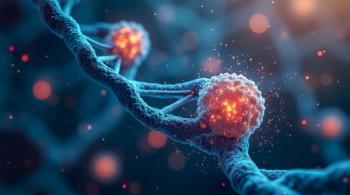
NUP98 Rearrangements Linked to Poor Outcomes in AML
Key Takeaways
- NUP98-NSD1 and NUP98-KDM5A fusions are linked to poor prognosis in AML, affecting OS and EFS significantly.
- NUP98-NSD1 is more common in pediatric AML, necessitating alternative detection methods like RT-PCR due to its cryptic nature.
Findings of a recent study indicate that NUP98 rearrangements can significantly impact outcomes in patients with acute myeloid leukemia (AML).
A recent systematic review and meta-analysis published in the
Results indicate that these genetic alterations significantly impact patient outcomes in AML.
The study, conducted by researchers from various institutions in Iran, analyzed data from 15 publications involving 6142 patients with AML. The meta-analysis showed a strong correlation between the NUP98-NSD1 fusion and poor prognosis in patients with AML. Univariate analysis of 2 studies with a total of 581 patients revealed that NUP98-NSD1 significantly increased the risk of poor outcomes (pooled HR, 3.67; 95% CI, 2.80–4.82; P = .000) with no heterogeneity (I²=00%; P = .322). Similarly, the multivariate analysis of 4 studies, including 4010 patients, reported a poor prognosis for OS (pooled HR, 2.84; 95% CI, 2.49–3.24; P = .000), albeit with significant heterogeneity (I²=96.65%; P = .018).
The pooled results from 2 multivariate analyses of EFS involving 1486 patients also demonstrated a significantly worse prognosis (pooled HR, 2.79; 95% CI, 1.87–4.16; P = .000) and no significant heterogeneity (I²=00%, P = .335). Previous studies found that NUP98-NSD1 was considerably more prevalent in the pediatric age group, with an average age of 9.1 ± 4.25 years.2,3 However, a separate analysis of children vs adults in this study could not be conducted due to a lack of access to detailed information.
The authors add that "NUP98-NSD1 has also been suggested for routine screening, MRD monitoring, and assessing patients' responses to therapy in patients with AML. However, due to its cryptic nature, it cannot be recognized by conventional karyotyping, which necessitates employing other methods, such as RT-PCR and sequencing."
The study also performed a subgroup analysis to assess the combined prognostic effect of NUP98-NSD1 and FLT3-ITD, a common AML mutation. The meta-analysis of 3 studies involving 543 patients revealed a pooled HR for OS of 2.60 (95% CI, 1.61–4.18; P = .000) with moderate heterogeneity (I²=60.71%; P = .078). For EFS, the pooled HR was 2.82 (95% CI, 1.86–4.26; P = .000) with lower heterogeneity (I²=29.42%; P = .242).
The authors note that they were only able to find 1 study that evaluated the prognostic effects of NUP98-NSD1 in patients with AML without FLT3-ITD and, "Interestingly, the results of this study showed that NUP98-NSD1 has a better prognostic effect in patients without FLT3-ITD than those harboring this mutation (HR,0.34; 95% CI, 0.048-2.4)." The authors also “recommend more studies evaluating the prognostic effects of NUP98-NSD1 in [patients with AML] without FLT3-ITD to shed more light on this issue.”
Similarly, multivariate analysis of 6 studies of 2835 patients showed a trend of poor outcomes for patients with the NUP98-KMDSA fusion, which is frequently found in pediatric patients with acute megakaryoblastic leukemia. The meta-analysis found that this rearrangement was associated with significantly worse outcomes for OS (pooled HR, 2.65; 95% CI, 2.5–2.81; P = .000), with no heterogeneity (I²=00%, P = .553). For EFS, the meta-analysis of 4 studies demonstrated a pooled HR of 2.35 (95% CI, 1.59–3.47; P = .000), with moderate heterogeneity (I²=39.86%; P = .173).
While this study provides evidence of the poor prognosis associated with NUP98 rearrangements, the authors acknowledge several limitations, including co-occurring genetic abnormalities, such as mutations in WT1 and NPM1, which may have contributed to the heterogeneity observed in some analyses. Additionally, differences in treatment protocols and patient demographics across studies may have influenced the findings.
References:
- Sheikhi M, Siyadat P, Rostami M, et al. Prognostic importance of NUP98-rearrangements in acute myeloid leukemia: a systematic review and meta-analysis. Caspian J Intern Med. 2024;15(4):579-588. doi:10.22088/cjim.15.4.579
- Heuvel-Eibrink MM, Arentsen-Peters ST, Pratcorona M, et al. NUP98/NSD1 characterizes a novel poor prognostic group in acute myeloid leukemia with a distinct HOX gene expression pattern. Blood. 2011;118(13):3645-3656. doi:10.1182/blood-2011-04-346643
- Gerbing RB, Loken MR, Raimondi SC, et al. NUP98/NSD1 and FLT3/ITD coexpression is more prevalent in younger AML patients and leads to induction failure: a COG and SWOG report. Blood. 2014;124(15):2400-2407. doi:10.1182/blood-2014-04-570929
- Gerbing RB, Loken MR, Raimondi SC, et al. NUP98/NSD1 and FLT3/ITD coexpression is more prevalent in younger AML patients and leads to induction failure: a COG and SWOG report. Blood. 2014;124(15):2400-2407. doi:10.1182/blood-2014-04-570929
Newsletter
Stay ahead of policy, cost, and value—subscribe to AJMC for expert insights at the intersection of clinical care and health economics.















































